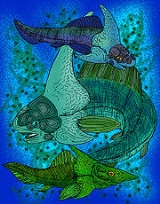
Acanthothoraci
Encyclopedia
Description
The Acanthothoraci ("Spine Chests") were a group of chimaeraChimaera
Chimaeras are cartilaginous fish in the order Chimaeriformes, known informally as ghost sharks, ratfish , spookfish , or rabbitfishes...
-like placoderms who were closely related to the rhenanid placoderms. Superficially, the acanthoracids resembled scaly chimaeras, lightly armored arthrodires, or (relatively) heavily armored ptyctodonts. They were distinguished from chimaeras by the presence of large scales and plates, a pair of large spines that emanate from their chests (thus, the order's name), tooth-like beak plates, and the typical bone-enhanced placoderm eyeball. They were distinguished from other placoderms due to differences in the anatomy of their skulls, and due to patterns on the skull plates and thoracic plates that are unique to this order.
The acanthothoracids were once thought to be closely related to the rhenanids because of similar arrangements of the plate armor, and that the patterns on the former's plates resemble the patterns of the latter's tubercle mosaics.
Fossil Record
Fossils of the Acanthothoracids are found in various deposits from the Lower Devonian throughout the world. The Palaeacanthaspids are found primarily in Europe and Canada, while the Weejasperaspids have only been found in the Taemas Wee Jasper reef, in Southeastern AustraliaAustralia
Australia , officially the Commonwealth of Australia, is a country in the Southern Hemisphere comprising the mainland of the Australian continent, the island of Tasmania, and numerous smaller islands in the Indian and Pacific Oceans. It is the world's sixth-largest country by total area...
.
While the Acanthothoracids' fossils date back to the Lower Devonian, they are believed to have arose during the Silurian
Silurian
The Silurian is a geologic period and system that extends from the end of the Ordovician Period, about 443.7 ± 1.5 Mya , to the beginning of the Devonian Period, about 416.0 ± 2.8 Mya . As with other geologic periods, the rock beds that define the period's start and end are well identified, but the...
, and that Silurian Acanthothoracids either lived in environments wholly unconductive to fossilization, or that their fossils have yet to be found.
Ecology
From what can be inferred from the mouthplates of fossil specimens, the acanthothoracids were ecologically similar to modern-day chimaeraChimaera
Chimaeras are cartilaginous fish in the order Chimaeriformes, known informally as ghost sharks, ratfish , spookfish , or rabbitfishes...
s, being a clique of shellfish hunters. Competition with their relatives, the ptyctodont placoderms, may have been one of the main reasons for the acanthothoracids' extinction prior to the Mid Devonian extinction event.
Relation to Other Placoderms
Most placoderm experts have reached a consensus that Acanthothoracida is the sister group of the rest of PlacodermiPlacodermi
Placodermi is a class of armoured prehistoric fish, known from fossils, which lived from the late Silurian to the end of the Devonian Period. Their head and thorax were covered by articulated armoured plates and the rest of the body was scaled or naked, depending on the species. Placoderms were...
, save for, perhaps, Stensioella and Pseudopetalichthyida. This is the result of a careful reexamination of the various members of the Acanthothoracid family Palaeacanthaspidae, in that particular species within that family share various anatomical similarities with other placoderm orders, particularly the anatomies of their braincase, dermal plate arrangement and bone histology
Histology
Histology is the study of the microscopic anatomy of cells and tissues of plants and animals. It is performed by examining cells and tissues commonly by sectioning and staining; followed by examination under a light microscope or electron microscope...
. As a result, that family is now considered to be paraphyletic due to the similarities its members have to primitive members of other placoderm orders.
The family Weejasperaspididae
Weejasperaspididae
Weejasperaspididae is a family of three extinct acanthothoracid placoderm species indigenous to the Early Devonian "Taemas-Wee Jasper" reef off the southeastern coast of Gondwanaland, located near what is now the town of Wee Jasper, in New South Wales, Australia.-Description:As with other...
, on the other hand, is considered to be monophyletic. Because of the Weejasperaspids' generalized anatomy, and strong similarities with the Palaeacanthaspids, but no overt similarities with any other order, save Brindabellaspida, they are regarded as either basal placoderms or very close to the basal placoderm.

